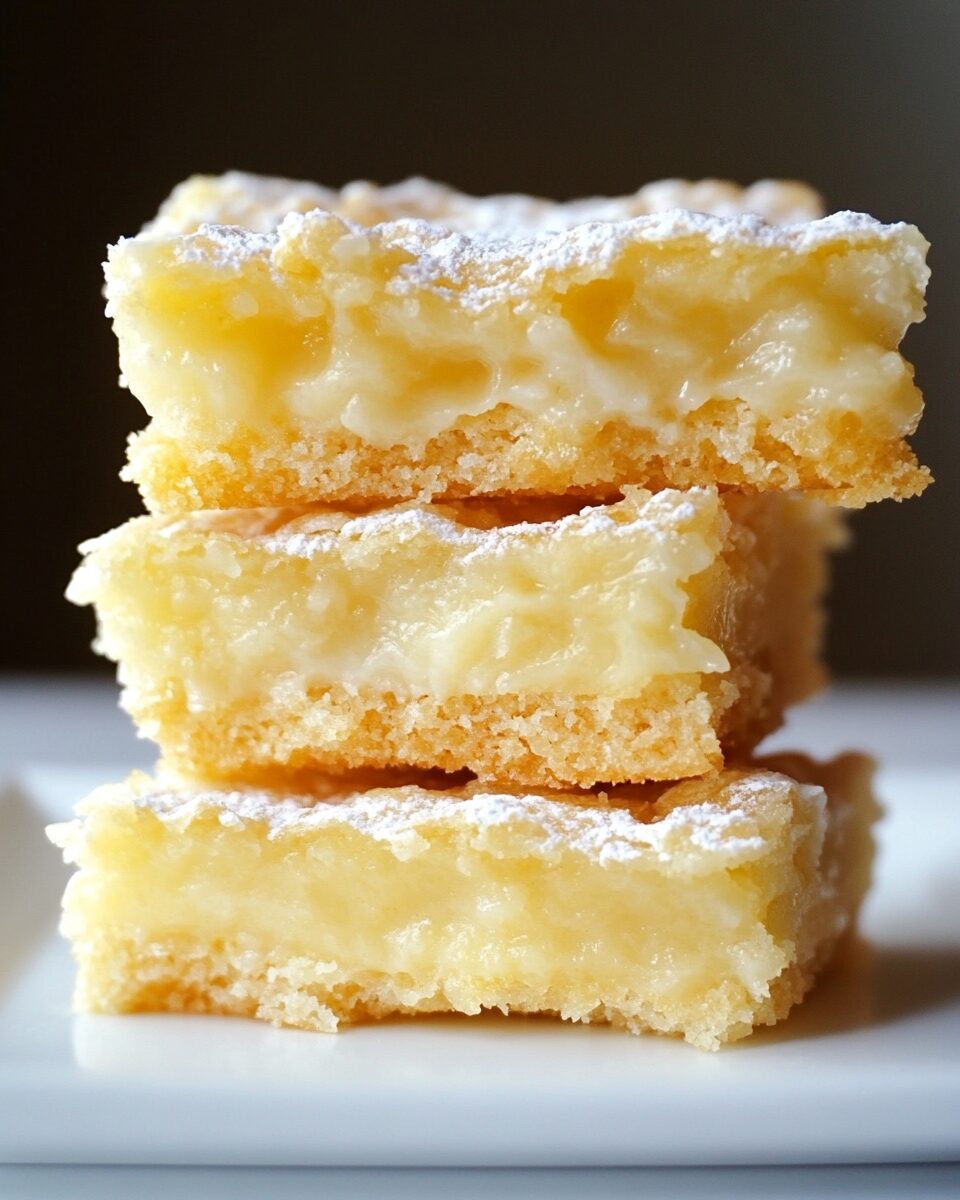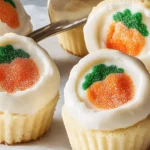Lemon bars are a classic dessert featuring a zesty lemon filling atop a buttery shortbread crust. Their bright flavor and delightful texture make them a favorite treat for many.
FULL RECIPE:
Ingredients
For the crust:
- 1 cup (2 sticks) unsalted butter, softened
- ½ cup granulated sugar
- 2 cups all-purpose flour
- ¼ teaspoon salt
For the filling:
- 4 large eggs
- 1½ cups granulated sugar
- ¼ cup all-purpose flour
- 2 teaspoons lemon zest
- ⅔ cup freshly squeezed lemon juice
- Powdered sugar, for dusting
Directions
- Prepare the crust: Preheat your oven to 350°F (175°C). In a medium bowl, cream together the softened butter and granulated sugar until light and fluffy. Add the flour and salt to the butter mixture, mixing until just combined. Press the dough evenly into the bottom of a greased 9×13-inch baking pan. Bake the crust for 15-20 minutes, or until lightly golden. Remove from the oven and set aside.
- Prepare the filling: In a separate bowl, whisk together the eggs and granulated sugar until well combined. Add the flour, lemon zest, and lemon juice to the egg mixture, whisking until smooth.
- Assemble and bake: Pour the lemon filling over the pre-baked crust, spreading it evenly. Return the pan to the oven and bake for an additional 20-25 minutes, or until the filling is set and slightly golden on top. Remove from the oven and allow the bars to cool completely in the pan.
- Serve: Once cooled, dust the top with powdered sugar. Cut into squares or rectangles and serve.
Nutrition Facts
- Calories: 139
-
Total Fat: 6.4g
- Saturated Fat: 3.8g
- Trans Fat: 0.2g
- Polyunsaturated Fat: 0.4g
- Monounsaturated Fat: 1.7g
- Cholesterol: 38mg
- Sodium: 55mg
-
Total Carbohydrates: 19g
- Dietary Fiber: 0.3g
- Sugars: 12g
- Protein: 1.7g
- Vitamin D: 0.2mcg
- Calcium: 7mg
- Iron: 0.5mg
- Potassium: 23.6mg
The History and Popularity of Lemon Bars
Lemon bars are believed to have originated in the United States in the mid-20th century, though their exact origins are debated. Many credit their creation to the rise of home baking trends in the 1960s when citrus-based desserts gained popularity. Lemon-flavored desserts have long been a staple in European cuisine, particularly in French and British baking, where lemon curd and tart-based treats were already well known. However, the American lemon bar as we know it today took these flavors and incorporated them into an easy-to-make, handheld treat. The popularity of lemon bars has endured for decades, with many families passing down their own variations of the recipe. They are a staple at bake sales, potlucks, and family gatherings, thanks to their bright and refreshing flavor. Lemon bars are also commonly found in bakeries and coffee shops, offering a deliciously tangy alternative to richer, chocolate-based desserts.
Why Lemon Bars are a Must-Try Dessert
One of the biggest reasons people love lemon bars is their irresistible combination of flavors and textures. The buttery shortbread crust provides a satisfying crunch that contrasts beautifully with the creamy, tart lemon filling. The addition of powdered sugar adds a hint of extra sweetness, balancing out the citrusy bite of the lemons. Another advantage of lemon bars is their simplicity. While they may look gourmet, they are relatively easy to make with just a few staple ingredients. Most home bakers already have the necessary ingredients in their kitchens, making lemon bars a convenient option for a last-minute dessert. Additionally, they require minimal effort compared to other baked goods like cakes or pastries, yet they still deliver a sophisticated flavor.
The Perfect Occasions for Lemon Bars
Lemon bars are the ideal dessert for any occasion. Their bright, citrusy flavor makes them especially popular in the warmer months, perfect for summer picnics, barbecues, and outdoor gatherings. They are also a fantastic addition to springtime brunches and tea parties, offering a refreshing contrast to heavier baked goods. During the holidays, lemon bars provide a light and tangy alternative to the rich, spiced flavors of traditional Christmas and Thanksgiving desserts. They make a wonderful addition to cookie platters and dessert tables, adding a pop of color and a burst of citrus flavor that complements seasonal treats like gingerbread and chocolate truffles. Lemon bars are also a popular choice for special events such as weddings, baby showers, and birthdays. Their elegant appearance and delicate dusting of powdered sugar make them a sophisticated yet simple dessert option. Plus, because they can be cut into small squares, they are perfect for serving large groups.
Health Benefits of Lemon Bars
While lemon bars are undeniably a treat, they do offer some surprising health benefits, thanks to their star ingredient: lemons. Lemons are packed with vitamin C, an essential nutrient that supports the immune system, promotes healthy skin, and acts as a powerful antioxidant. The natural acidity of lemons can also aid digestion and help balance the body’s pH levels. However, like most desserts, lemon bars should be enjoyed in moderation. They do contain sugar and butter, which contribute to their deliciously indulgent taste. For those looking to make a slightly healthier version, modifications can be made by reducing the sugar content, using whole wheat flour for the crust, or incorporating healthier fat alternatives like coconut oil. Some recipes even use natural sweeteners like honey or maple syrup instead of granulated sugar.
How to Store and Serve Lemon Bars
Lemon bars are best served chilled or at room temperature. After baking, they should be allowed to cool completely before slicing, as this helps the filling set and ensures clean, even cuts. Dusting them with powdered sugar should be done just before serving to prevent the sugar from dissolving into the moisture of the filling. For storage, lemon bars should be kept in an airtight container in the refrigerator. They typically last for about five days, making them a great make-ahead dessert option. If you need to store them for longer, lemon bars can also be frozen. Simply place them in a single layer on a baking sheet, freeze until solid, then transfer them to an airtight container or freezer bag. When ready to serve, thaw them in the refrigerator overnight.
Common Mistakes When Making Lemon Bars
While lemon bars are relatively easy to make, there are a few common mistakes that can affect their texture and flavor. One of the most frequent issues is underbaking or overbaking the crust. The shortbread crust should be baked just until it turns golden, as overbaking can make it too hard and underbaking can lead to a soggy base. Another common mistake is not properly mixing the lemon filling. It’s important to whisk the eggs, sugar, lemon juice, and flour thoroughly to create a smooth, even mixture. Failing to do so can result in a grainy or lumpy filling that doesn’t set properly. Some bakers also struggle with getting the right balance of sweetness and tartness. Since lemons can vary in acidity, tasting the filling mixture before baking can help determine if additional sugar is needed. Using freshly squeezed lemon juice instead of bottled juice is always recommended, as fresh juice provides a brighter, more natural citrus flavor.
Conclusion
Lemon bars are a classic dessert that has stood the test of time for good reason. Their delightful combination of sweet and tart flavors, paired with a buttery shortbread crust, makes them a favorite among dessert lovers. They are easy to prepare, versatile enough for any occasion, and provide a refreshing alternative to heavier sweets. Whether you are baking them for a summer picnic, a holiday gathering, or simply as a treat for yourself, lemon bars are sure to be a hit. Their bright, citrusy flavor and beautiful presentation make them a standout dessert that never goes out of style. If you haven’t yet tried making lemon bars at home, now is the perfect time to experience their deliciousness for yourself.






